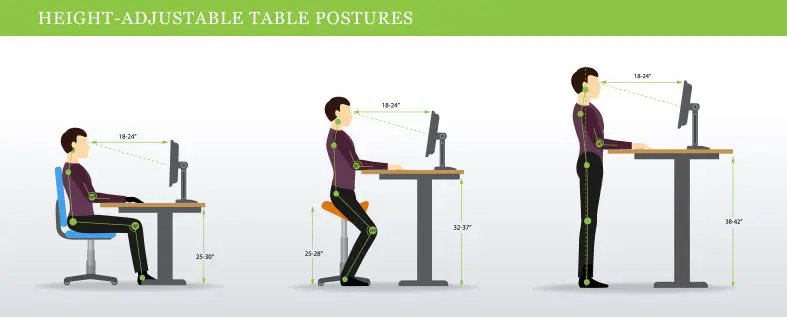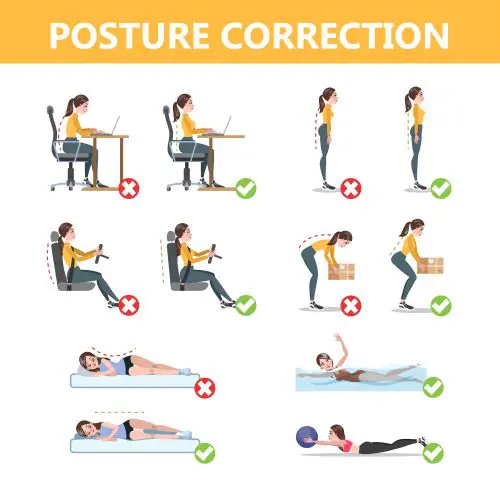TIPS TO MAINTAIN GOOD POSTURE
Good posture is often championed widely as being essential to remain in great health, regardless of your goals and tips to maintain this can be very helpful. Many adults move with a poor posture, which has a negative impact on their spine, which is visible to others. However, only a few people are aware of the true importance of maintaining good posture. It is important no matter what you do during the day whether it be sitting or lifting heavy things. It is equally important when running as poor posture can be a source of energy leaks and wasted effort.
WHAT IS POSTURE?
Posture is the position our bodies are in when we sit, stand, or lie down. A good posture is one in which the body parts are in proper alignment and supported by muscle tension against gravity. The absence of proper posture and the proper function of the muscles responsible for holding us in position, we would be unable to move anywhere easily. Efficiency of posture allows efficiency of movement.
Our normal posture is not consciously maintained or controlled by us most of the time. Certain muscles habitually take care of this, including large muscle groups such as the back muscles and hamstrings. While bone ligaments are responsible for holding the skeleton together, postural muscles are responsible for preventing gravitational forces from tipping us over. These muscles also enable us to move with balance and maintain appropriate posture while doing so. The fact that we normally walk and run on two legs is unique among animals and is thought to be one of the main factors that drove the evolution of our unique neurology. Standing and running as we do now frees our hands to allow use of tools and caring for others. The system that keeps us upright is extremely complex, but there are multiple factors that can interfere with proper posture.
WHY IS GOOD POSTURE IMPORTANT?
Maintaining proper posture is crucial to lie, sit, walk, and stand in positions that do not strain our ligaments and supporting muscles during physical activities. Good posture also keeps the joints and bones aligned properly to ensure the muscles are being used the right way. It prevents joint surfaces from wearing out at an abnormal pace, a condition that could cause joint pains and degenerative arthritis. Good posture tips can be used to prevent pain in the muscles and the back and can guard against overuse disorders and muscle strain. Muscles work efficiently when they are held in the right alignment, thus reducing the body’s energy consumption and preventing muscle fatigue. Proper posture also minimizes the stress placed on your ligaments responsible for holding your joints together, thus minimizing injuries.
In order to maintain proper posture, you’ll require adequate muscle strength and flexibility and a normal range of joint motion in different body regions. Your postural muscles need to be efficient and balanced on both spinal ends as well. Additionally, you must also recognize poor postural habits and seek to rectify them whenever possible.
EXAMPLES OF POOR POSTURE
- Rounded Shoulders
- Slumping
- Forward Pelvic Tilt

CONSEQUENCES OF POOR POSTURE
A poor posture may result in your postural muscles being subject to excessive strain and lead to them relaxing when they’re held for too long in a certain position. For instance, people who work while seated on chairs for long hours at their workplace tend to bend forward near the waist. As a result, they are prone to back pain and injury. Several other factors may also result in poor posture, such as high heeled shoes, abnormally tight muscles, weak postural muscles, pregnancy, obesity, and stress.
Additionally, unhealthy standing and sitting habits, incorrect working posture, a hectic work environment, and decreased flexibility can cause poor body posture as well. Poor posture decreases the efficiency of running as muscles not involved in propelling you forward need to work and use up energy to hold you up. Use the following tips to help you maintain or regain good posture.
TIPS FOR GOOD SITTING POSTURE
- Don’t sit still on a chair or a surface for a long period of time but keep taking breaks at regular intervals.
- Maintain your forearms in a parallel position to the ground and your shoulders in a relaxed state.
- Adjust your chair’s backrest in order to support your mid- and lower-back region. A back support can also help you immensely.
- Keep your knees below or at the hip level.
- Ensure the front portion of your seat and the back of your knees have a gap between them.
- Do not cross your legs and ensure that your ankles are in front of your knees.
- Ensure your feet are always on the floor while you sit. If you’re unable to do that, consider getting a footrest.
TIPS FOR GOOD STANDING POSTURE
- Ensure that your weight is being primarily borne by the ball of your feet.
- Keep the knees bent slightly.
- Shift your body weight from toes to heels or keep switching between your feet if you need to stand still for long periods of time.
- Ensure your stomach is tucked in at all times.
- Stand tall and straight with the shoulders pulled backward.
- Ensure your head is in a level position at all times – the earlobes have to be in the same line as your shoulders. Don’t push the head to the side, backward, or forward.
- Allow your arms to hang naturally by your body.
- Ensure your feet are about a shoulder’s width apart.

IS THERE A RIGHT WAY TO LIE DOWN?
- If you prefer sleeping on your back, have a pillow underneath your knees.
- If you prefer sleeping on your side, have a pillow underneath your legs.
- You can resolve back pain issues by sleeping on your back or side.
- Do not sleep on your stomach.
- Sleeping with a proper pillow can help resolve postural problems that arise due to poor sleeping positions.
- Find a mattress that simply works for you. Although strong mattresses work well for most people, a soft mattress works better for certain people with back pain. In any case, it’s your comfort that matters the most.
CAN I CORRECT MY POOR POSTURE?
Yes. The tips that we gave you above are the beginning steps required to get good posture. However, if your postural problems have been around for a long time, it will take longer to resolve them since your joints might have adapted themselves to the poor posture by then. Being conscious of poor postural positions and keeping yourself informed of the best postures to walk, sit, and stand in, can help you make the right choices. You’ll be able to eventually program the right postures to your muscle memory with practice, which will eventually improve your body’s default positions.
A healthcare provider like a chiropractor certified in sports medicine can help you by recommending the right postures to be in and set an exercise regimen that will strengthen important core muscles.
Your healthcare provider can review and correct your posture and form with certain exercises to ensure you are moving properly, thus reducing your chances of injury as well. Systems like the SFMA can be used to find postural imbalances and asymmetries. And while corrective exercises are helpful, chiropractic adjustments, Graston Technique, massage therapy can all be additional things that help you to improve your posture. Correcting poor posture can improve performance and lead to running more efficiently and finishing the race faster.

